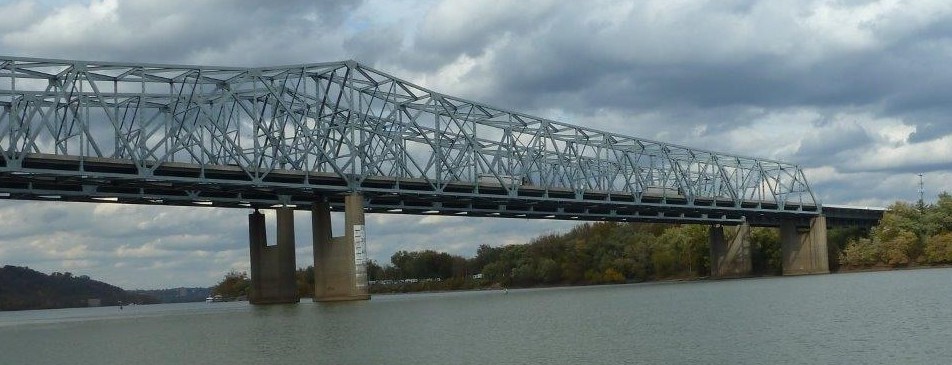
Results from a UC student project could protect Cincinnati’s water supply
Greater Cincinnati Water Works will present the students’ findings at an upcoming conference
Research from an undergraduate capstone project could help prevent future contamination of Cincinnati’s water supply.
Environmental engineering students at the University of Cincinnati spent a year working on their senior project, in conjunction with Greater Cincinnati Water Works, to determine how to best prevent any accidental hazardous spills on a bridge from ending up in the city’s drinking water.
“If we mitigate risk by removing the potential for contamination whenever we can, that helps us in our overall treatment approach,” said Richard Stuck, source water protection manager for the water company's water quality and treatment division. “It’s much easier and cheaper to keep the contaminants out of the water in the first place than it is to take them out once they are there.”
The Ohio River Source Water Alliance, of which the water company is a member, identified the Combs-Hehl Bridge as a high-priority potential source of contamination in the Ohio River. As many as 10 trucks per hour carry hazardous materials across the bridge. A spill on the bridge caused by a traffic accident could potentially reach a water intake within 15 minutes, depending on the river flow, which would give little time for the water treatment plant to react.
Currently, storm water drains are located across the length of the bridge, so a spill could enter the Ohio River at any point. The goal of the project was to reduce the risk of a hazardous spill from the Combs-Hehl Bridge by diverting the bridge downspouts to the Ohio side of the river away from the GCWW intake on the Kentucky side. The optimal location of the discharge was determined from results of a 3D computational fluid dynamic model.
“The purpose of the dye study was to gain a better understanding of the river’s flow patterns downstream of the bridge so we can design an effective spill diversion system that will help safeguard the drinking water,” Stuck added.
Stuck plans to present the students’ results next month at the American Water Works Association’s Sustainable Water Management Conference in a session on spill and preparation response.

Dye released into the river allowed the GCWW team and the student researchers to observe river flow patterns to determine where a potential spill from the Combs-Hehl bridge would travel. Photos courtesy of Richard Stuck/GCWW.
The team was comprised of UC students Bethany Caspersz, Matthew Cummings, Dexter Adams and Qianhui Xia. They were on the boat in 2018 when the water company collected data through a dye study to measure the lateral flow of the river mixing from the bridge. They were able to watch firsthand as the magenta dye dispersed along the river currents.
Once that data was collected, the students got to work to determine flow patterns of the river so they could model how to make any dangerous substances coming from the bridge flow past rather than into the water intake.
The students were tasked with researching and choosing the best numerical modeling software for the job. After evaluating eight software options, the students selected Flow-3D. (Flow Science, which produces the software, provided them with a free license upon learning of the project.)
The team had to learn the selected software, which came with a steep learning curve. Next, they calibrated their model using data captured from the river dye study and through simulations to determine the optimal placement of bridge discharge to divert any potential contaminant spills away from the intake.
This project was one of the 2019 capstone projects from UC professor Drew McAvoy’s Environmental Engineering capstone course for undergraduates in their final year at UC. He wants his students to work on a project with real-world implications, so he recruits sponsors, like Greater Cincinnati Water Works, that have a problem that needs to be solved.
“The students are working with sponsors who have a real interest, so there is a sense of accomplishment and purpose. It’s ‘real world’ in that they are presented with a problem that they’ve never had to deal with before and they have to figure out how to solve it,” McAvoy said.
Students prepared a professional-level report and presented their findings to outside judges who evaluated and ranked the students’ projects. In the spring of 2019, the water works project earned the top spot.
Bethany Caspersz, who served as the student team’s project manager, graduated in May ’19 and is now working as an environmental consultant specializing in air quality for Trinity Consulting. She said the style of the capstone – research, cost analysis, consulting with a team, and translating the results into a clear report and presentation – mirrors the progression of events in her work as an engineer.
“I thought this project was a very interesting opportunity to explore the realm of water quality and contamination threats and to build my modeling skills, while also creating a real impact for the staff of GCWW and Northern Kentucky Water District and the millions of people who receive water daily from these water utilities,” Caspersz said.
Related Stories
UC lab-on-a-chip devices take public health into home
May 8, 2025
University of Cincinnati engineers created a new device to help doctors diagnose depression and anxiety. The “lab-on-a-chip” device measures the stress hormone cortisol from a patient’s saliva. Knowing if a patient has elevated stress hormones can provide useful diagnostic information even if patients do not report feelings of anxiety, stress or depression in a standard mental health questionnaire.
UC engineering students recognized for achievement in...
May 1, 2025
Sixteen UC engineering students were honored for outstanding achievement in cooperative education at the close of the 2024-2025 school year.
UC recognizes students for innovation achievement and leadership
April 30, 2025
Read about the University of Cincinnati’s undergraduate innovation awards for 2025.
